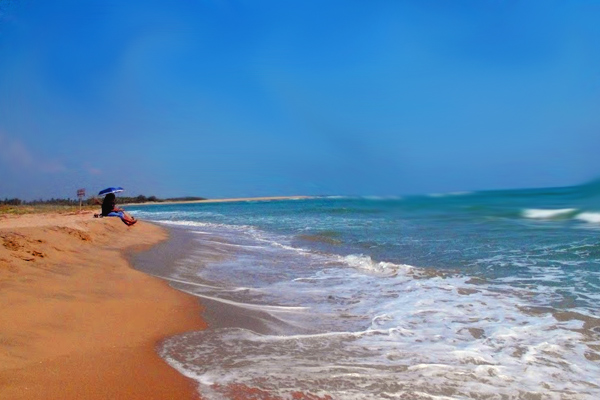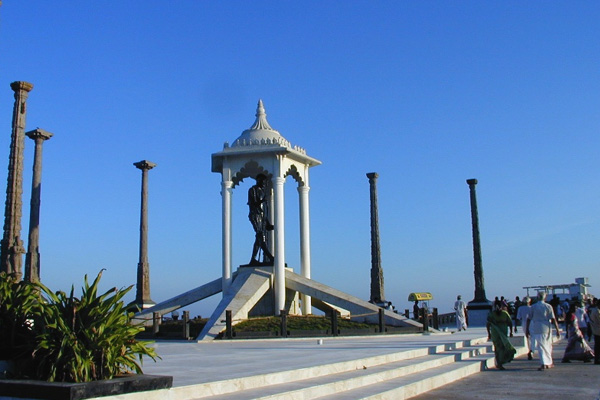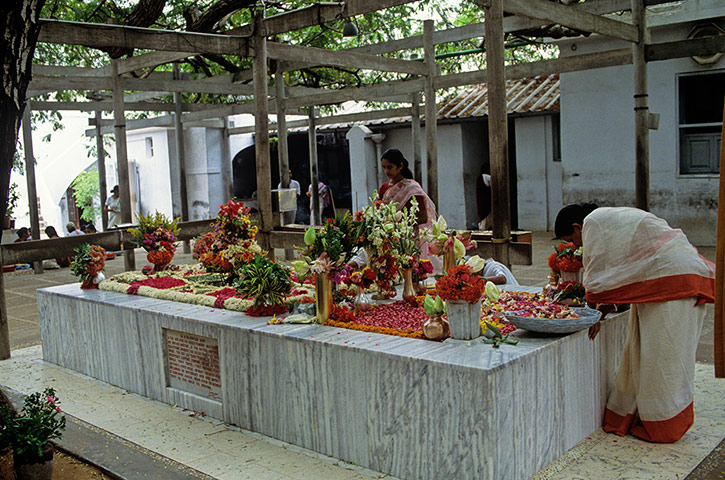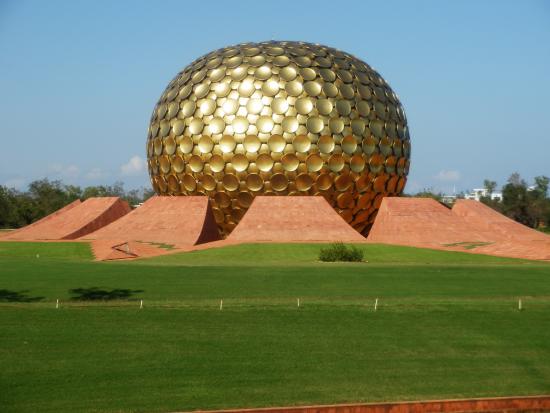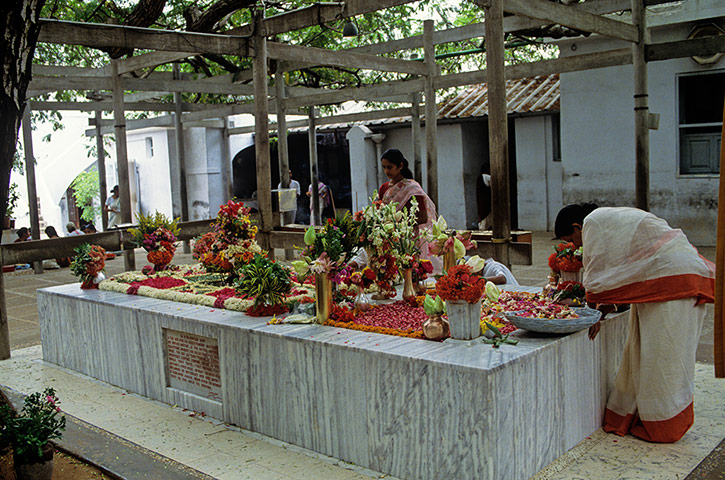Puducherry, The French Rivera of the East
General Information
Other Name:PondyDistrict:PondicherryState:PondicherryCountry:IndiaArea:492 Sq. Km.Language Spoken:Tamil, French, English, Hindi and local dialects.Long Distance Code:+91-413Importance:Famous for the spiritual Aurobindo Ashram.Best Time To Visit:October to FebruaryDescription:
Pondicherry... the small little French settlement on the eastern coast of the Indian subcontinent, tucked into the vast state of Tamilnadu is one of the most beautiful and vibrant union territories of India. Fondly known as Pondy, this union territory of India is an amalgam of various cultures. A blend of spiritual aura with the Aurobindo Ashram, the French colonial heritage in the magnificent churches and the buildings, and the Tamil culture of the original inhabitants is what Pondicherry actually is. Along with its beautiful beaches and lovely resorts, this less explored land has many things to offer. Quiet beaches and colonial buildings, spiritual Aurobindo Ashram and Yoga training, wonderful cuisine, a blend of Tamil and French, and unique souvenirs to take along; this tiny and sleepy township is a tourists' paradise. One can explore into the state of Tamilnadu or can visit the other towns of Pondicherry, the Karaikal, the Mahe and the Yanam.
Pondicherry… actually a small cherry on the huge tree of Tamilnadu and obviously the juiciest one! The significance of unity in diversity acquires a new meaning in this place, lovingly called Pondy, Pondicherry. A place where the Boulevard streets still adorn the city, the lovely smell of the freshly baked breads and sambhar tour the city hand in hand, Pondicherry is a fine blend of two totally different international cultures living side by side without interference for centuries now. This once upon a time French colony takes you to a place within Tamilnadu which so much unlike Tamilnadu. The orthodox nature of the Tamilians is not so prominent and neither is the French unpretentious open nature so prominent here. The people have lived together and mingled with each other for centuries and that is evident from the daily life of the city, based on non - interference and sharing enjoyment.
Long back Pondicherry bore the name of Vedapur, a seat of Vedic Culture, that's what it seems to be from the plaques found in some temples nearby. It is also believed that it was the abode of the great sage Agastya. Situated on the seashore it definitely was an important port for trading. It is believed that trading to the ancient cities of Greece and Rome in 100 B.C. took place from the port of Pondicherry. This has been proved with the remnants of the ancient port town which was excavated recently 6 kms from Pondicherry at Arikamedu.
The Pallava kingdom put its stronghold on Pondicherry in the early fourth century A.D. and soon after the Chola dynasty started ruling the region but only to give away to the Pandya kingdom of the south. Some coins of the Chola dynasty excavated, also at Arikamedu, prove the town to be a flourishing port town during the rule of the Chola dynasty. After a brief invasion by the Muslim rulers of the North, who established the Sultanate of Madurai, the Vijayanagar Empire took control of almost all the South of India and lasted till 1638, when the Sultan of Bijapur began to rule over Gingee.
By this time the Dutch, the Portuguese and the French had already started making steady advances at some invaluable port towns of India. Pondicherry was no different. The Portuguese and the Dutch started making advances here but could not establish a stronghold, partially because of the King of the Gingee. Instead he invited the French to give a tough fight to the Dutch. It was in 1638 A.D. that Pondicherry started with the foreign rule which went on for nearly 300 years in a row.
Many of the local inhabitants were converted to Christian, some by force and the others willingly. Along with Pondicherry the other three places of Karaikal, Mahe and Yanam also came under the rule of the French.
Today's Pondicherry bears the marks of the by gone glorious era. The French Governors like Francois Martin and Dumas worked hard for the upliftment of the People of Pondicherry and tried to improve their living conditions. This French legacy is visible in the well-planned town, neatly laid roads, wide and vibrant beaches, beautiful promenades, architecturally imposing churches and public buildings.
It was much later the great saint Aurobindo Ghosh found solace in this place and built an Ashram here which has become a prominent place for spiritual seekers worldwide.
Although India gained freedom in 1947, Pondicherry and its districts were handed over only in 1954 and officially the treaty was signed in 1963. Since then Pondicherry has been the Union territory of India along with Karaikal, Mahe and Yanam.
Pondicherry is very much an Indian town, and yet different from the rest. Its unique history and traditions have carved a niche of its own. Agriculture is the main occupation of the people here and the though the town bears an impression of a French colony, the surroundings are still traditionally sowed and crops are grown. The people originally of the Dravidian origin are hospitable clan. Some elderly people, who have seen the French rule, can speak fluent French and many have French passports as well. The food is essentially south Indian with a blend of French cuisine. Seafood is preferred here.Location:
Pondicherry has three other districts namely, Yanam, Mahe and Karaikal. Pondicherry itself is situated in the northern parts of the vast state of Tamilnadu and is located at the distance of 165 kms from Chennai, the capital of Tamilnadu. Karaikal is also in the state of Tamilnadu in the district of Thanjavur at the distance of 150 kms from Pondicherry. Yanam lies in the state of Andhra Pradesh around 840 kms north east of Pondicherry while Mahe is in the state of Kerala around 650 kms east of Pondicherry.Climate:
Situated on the eastern coast of the Indian Sub - Continent, this small Union Territory of India experiences a humid climate throughout the year. The winter months of December and January are pleasant and October, November and February are good.
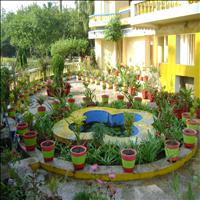 Sri Aurobindo Ashram is located in Pondicherry, a small coastal town 160 km south of Chennai, in South India. Visitors wanting to travel to Pondicherry will most likely have to pass through Chennai, whether they arrive there by air, train or road, and thereafter cover the remaining distance to Pondicherry by road, a journey which generally takes about 3 hours.
Several private and government-owned buses leave Chennai for Pondicherry every half-hour. However, visitors arriving at the Chennai Airport, or even those with a lot of luggage, might find it more convenient to hire a taxi for this leg of their journey.
Pondicherry is also connected directly by air with Bengaluru (Bangalore) with a few flights a week. There are convenient connections from Bengaluru to major Indian cities.
A limited number of rooms are available in Ashram guest houses for visitors coming for a short visit to Sri Aurobindo Ashram. Since accommodation is limited and is often fully booked, it is advisable to make reservations in advance. A list of guest houses that accept advance bookings is provided here, along with a brief description of the facilities they provide. In case visitors come to the Ashram without a confirmed booking, they may approach the Bureau Central, which allots rooms according to requirements, provided accommodation is available.
While it is possible to enter the main Ashram building freely during visiting hours, some sections of the Ashram require that you obtain a pass before you can be allowed to enter. If you get accommodation in any of the Ashram Guest Houses, you will be given the appropriate passes. However, for those not staying at an Ashram guest house, the Bureau Central can help by providing information and the pass you might need.
The Bureau Central office, designed as an exhibition hall, also provides an introduction to the vision of Sri Aurobindo and The Mother and their method of spiritual practice, through permanent exhibits of photographs, captions, text, videos and books.
There are daily conducted tours for those interested in visiting the various units of the Ashram, the Pondicherry town, as well as the Auroville township.
Sri Aurobindo Ashram is located in Pondicherry, a small coastal town 160 km south of Chennai, in South India. Visitors wanting to travel to Pondicherry will most likely have to pass through Chennai, whether they arrive there by air, train or road, and thereafter cover the remaining distance to Pondicherry by road, a journey which generally takes about 3 hours.
Several private and government-owned buses leave Chennai for Pondicherry every half-hour. However, visitors arriving at the Chennai Airport, or even those with a lot of luggage, might find it more convenient to hire a taxi for this leg of their journey.
Pondicherry is also connected directly by air with Bengaluru (Bangalore) with a few flights a week. There are convenient connections from Bengaluru to major Indian cities.
A limited number of rooms are available in Ashram guest houses for visitors coming for a short visit to Sri Aurobindo Ashram. Since accommodation is limited and is often fully booked, it is advisable to make reservations in advance. A list of guest houses that accept advance bookings is provided here, along with a brief description of the facilities they provide. In case visitors come to the Ashram without a confirmed booking, they may approach the Bureau Central, which allots rooms according to requirements, provided accommodation is available.
While it is possible to enter the main Ashram building freely during visiting hours, some sections of the Ashram require that you obtain a pass before you can be allowed to enter. If you get accommodation in any of the Ashram Guest Houses, you will be given the appropriate passes. However, for those not staying at an Ashram guest house, the Bureau Central can help by providing information and the pass you might need.
The Bureau Central office, designed as an exhibition hall, also provides an introduction to the vision of Sri Aurobindo and The Mother and their method of spiritual practice, through permanent exhibits of photographs, captions, text, videos and books.
There are daily conducted tours for those interested in visiting the various units of the Ashram, the Pondicherry town, as well as the Auroville township.Timings: 8AM–12PM, 2–6PM
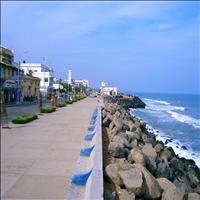 A popular beach adoring the coastline of the city of Pondicherry, this long 1.2 kilometers is a haven for travelers and beach enthusiasts. Starting from the War memorial and ending at the Dupleix Park on the Goubert Avenue, the beach is also a favorite haunt for locals for the morning and evening walks besides being an all-time favorite picnic destination. As you explore the beach, you will find a statue of Mahatma Gandhi which is followed by a sea-facing restaurant to enjoy some local culinary delights.
For those who want to enjoy the warm moments and pick up some souvenirs there are small tea, snacks and souvenir shops from where you can pick a memory or enjoy some peanuts while taking in the cool breeze of the sea. The sunrise and sunset views from the beach are especially beautiful and so does the view of moon shimmering on the sea waters.
A popular beach adoring the coastline of the city of Pondicherry, this long 1.2 kilometers is a haven for travelers and beach enthusiasts. Starting from the War memorial and ending at the Dupleix Park on the Goubert Avenue, the beach is also a favorite haunt for locals for the morning and evening walks besides being an all-time favorite picnic destination. As you explore the beach, you will find a statue of Mahatma Gandhi which is followed by a sea-facing restaurant to enjoy some local culinary delights.
For those who want to enjoy the warm moments and pick up some souvenirs there are small tea, snacks and souvenir shops from where you can pick a memory or enjoy some peanuts while taking in the cool breeze of the sea. The sunrise and sunset views from the beach are especially beautiful and so does the view of moon shimmering on the sea waters. 


